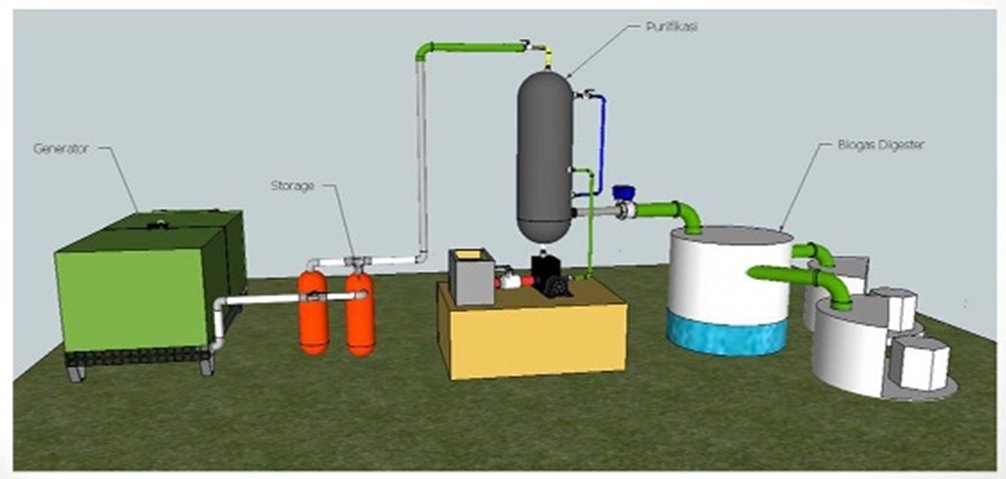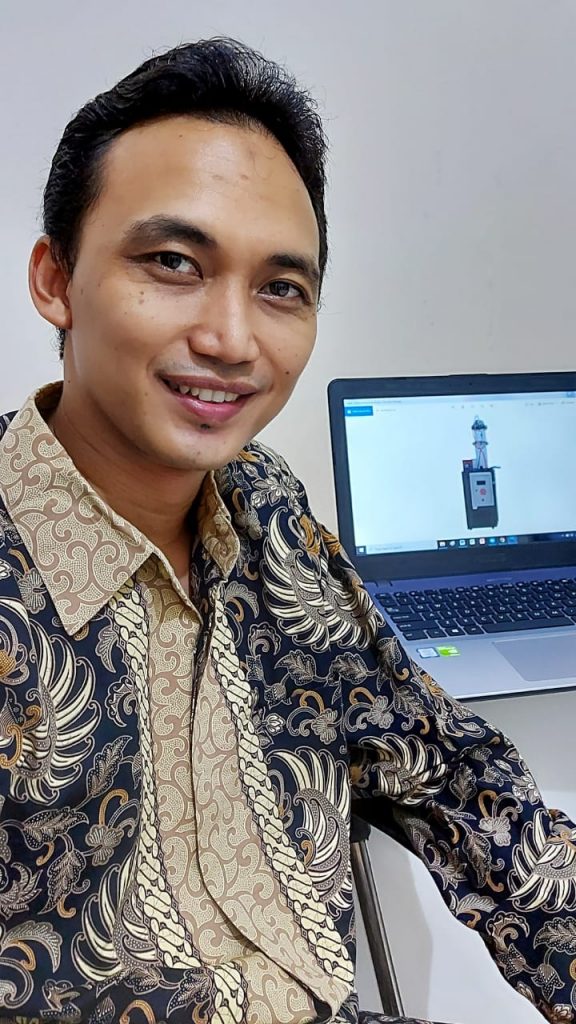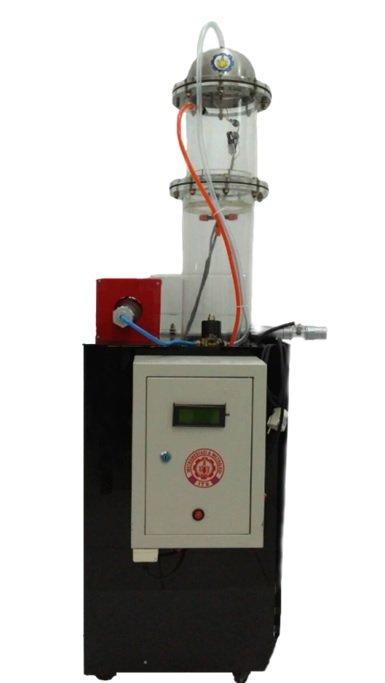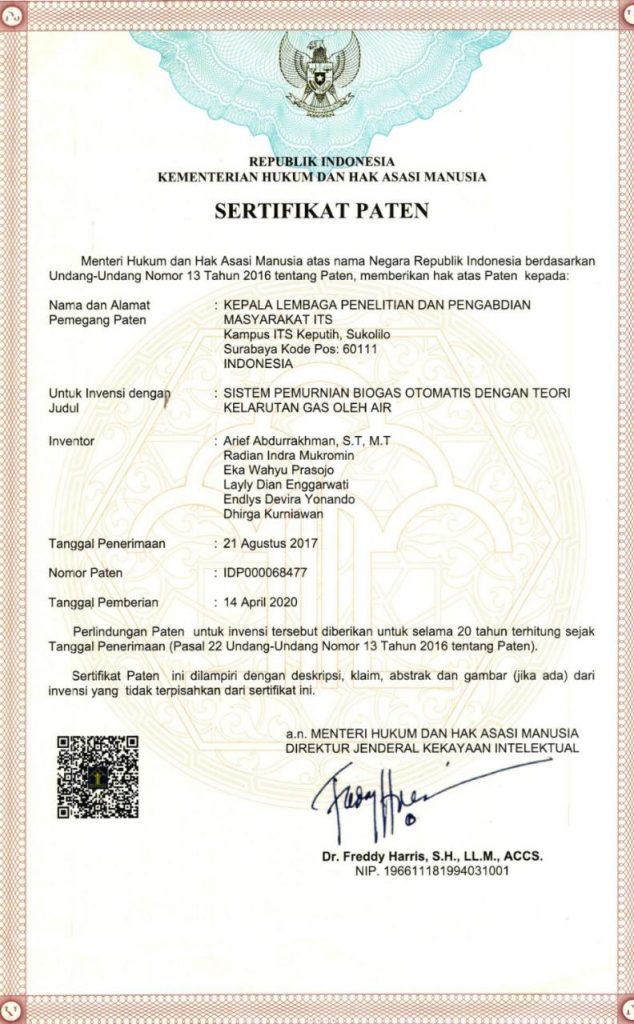Developing Biogas Purification Equipment, ITS Lecturers Successfully Achieved Patents

The flow of Biogas Purification System by the lecturer of Department of Instrumentation Engineering ITS, Arief Abdurrakhman ST MT and Team
ITS Campus, ITS News — one more encouraging news that adds to the long list of achievements of the Institut Teknologi Sepuluh Nopember(ITS). First present in the year 2017 ago, an invention developed by the research team of the Department of Instrumentation Engineering ITS managed to obtain patents from the Directorate General of Intellectual Property (DTKI) Ministry of Justice and Human Rights (Kemenkum HAM) RI.
Through the development of the automated Biogas purification system with the Gas solubility theory by Air, Arief Abdurrakhman ST MT with the five students of Department of Instrumentation Engineering acquired the patent for the idea of the product. Arief said that the product was made based on common concerns in seeing the potential utilization of natural resources, primarily for renewable energy.
Based on the information reported from the Ministry of Energy and Mineral Resources (ESDM) official website, the government has committed to realizing the electricity supply of 35 thousand Megawatt (MW). 25 percent of these targets are sought to come from renewable energy. “The potential of Indonesian natural resources is remarkable, but only 15 percent are fulfilled into renewable energy,” said Arief.

Arief Abdurrakhman ST MT with his Biogas Purification Equipment on screen
Therefore, the head of the Sub-Directorate of Entrepreneurship and Career Development ITS is trying to optimize the utilization of biogas into a renewable energy source. His team analysis showed that the East Java area itself which includes Malang, Pasuruan, and other cities focusing on the livestock sector has not utilized the waste of cow dung as the primary raw material of biogas in maximum. “In fact, from about 20,000 biogas reactors in Indonesia, about 7,000-8,000 are in the East Java region,” he added.
According to Arief, the lack of optimization of biogas utilization is not without reason. Arief explained that the biogas directly removed from the reactor to the environment can cause danger. This is due to not only methane that exists in the biogas content, but there is also the content of its impurities “Like hydrogen sulfide and carbon dioxide that affect the greenhouse effect and become the cause of global warming,” he continued.
Lecturers who born 12 July 1987, added, in a biogas reactor that has not been equipped with purification tools, the content of the ignition can reach 40-50 percent. Consequently, a surplus of biogas produced by the household industry can not be directly exploited by the community. “This is because biogas with a high-impurities content that is directly channeled to the Genset will cause damage to the engine generator,” he explained.
On that basis, Arief and the team initiated a biogas purification system by relying on materials that are relatively easy to obtain. Given that many overseas biogas purification systems are usually industrial-scale, Arief and the team are seeking to manufacture for household scale. “Especially to help the cattle farmers to be able to convert biogas from cow dung into electrical energy,” he described.

Automated Biogas Purification System Tool with Gas solubility by water, from the lecturer of Department of Instrumentation Engineering with his team
With the product of the biogas purification system he made, Arief revealed that the resulting biogas composition can contain 80-90 percent methane. The more content of methane in the biogas, the more feasible to be supplied to the Genset because there are not many pollutants contained. “Therefore, in the combustion chamber in the Genset will make more use of methane supply,” explained the alumnus of the Department of Physics Engineering ITS.
Arief said the system made in this biogas purification product is sustainable because the supply for generators can not be disjointed. Volatile biogas production makes it accommodated in a shelter, then purified and accommodated in the biogas purification. Afterward, the biogas purification result is streamed directly to Genset. “This product has been tested in the region of Nongkojajar village, Malang Regency and Superdepo Sampah Surabaya,” he explained.
The added value of this biogas purification system product is the monitoring system. Users of these products can find out the number of gases included in the equipment (inputs), the composition of gases, and the output of gas after purification (output). “So if it has not reached the minimum requirement to be channeled to the generator, the gas will return to the initial process of purification automatically,” said Arief.
This biogas purification product uses material that is easily obtained because of its basic material in the form of water-based on the principle of Gas solubility theory, so there are no constraints in the supply of raw materials. “The challenge in our research is on testing in a biogas reactor factory that sometimes needs a good wiring system so that the mobility is good,” continued consultant in the field of instrumentation, control, and renewable energy PT ITS Tekno Sains.

Certificate of the patent for Automated Biogas Purification System with Gas solubility by water theory received by ITS lecturer, Arief Abdurrakhman ST MT, and Team
With the patent of this biogas purification product, Arief and the team plan to make the packaging more compact and mass producing, so that it can be used by farmers who have biogas reactors. Thus, it can be produced biogas which is used as a source of electrical energy and can turn on electronic devices in rural areas. “We hope to present the independent energy village that can provide electrical energy independently,” he said.
Arief also hopes that the acquisition of patents for this research product will inspire other academic civitates to not only focus on the achievement of Scopus indexed journals. However, the technology is supposed to be done downstream to patents and benefits for the community. “The synergy between lecturers and students in the laboratory must be optimized, which I believe other academic civitates can do better,” he concluded. (tri/rev/ITS Public Relations)
Related News
-
ITS Rises to Second Rank in Most National PKM Funding
ITS Campus, ITS News – Strengthening its determination in the scientific field, the Institut Teknologi Sepuluh Nopember (ITS) succeeded
June 25, 2020 10:06 -
Examining Kenny, the Best ITS Bachelor Graduate with a GPA of 3.94
ITS Campus, ITS News — Educating for 3.5 years at the Institut Teknologi Sepuluh Nopember (ITS) did not prevent Benedictus
June 25, 2020 10:06 -
Inspirational, Deaf ITS Graduates Graduated with Cumlaude Predicate
ITS Campus, ITS News — An inspiring story was also present at the 129th Graduation Ceremony of the Institut Teknologi
June 25, 2020 10:06 -
129th Graduation: ITS Graduates 1,355 Candidate Leaders
ITS Campus, ITS News – Institut Teknologi Sepuluh Nopember (ITS) again held a graduation procession for its students through the
June 25, 2020 10:06
